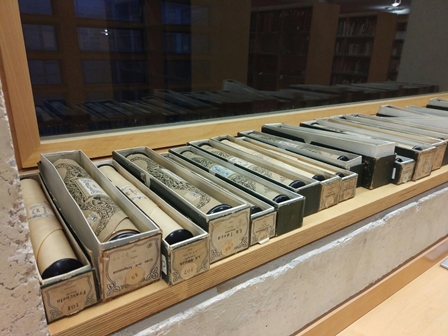
News
Piano rolls from Barcelona Museum of Music
The piano rolls’ collection of the Barcelona Museum of Music has many characteristics that allow us to describe it as important, either by the way of arrival, due to the good condition of the recordings, the diversity of brands and factories that are represented (almost 50!) or the high amount of artists rolls that exist. All of them allow us to know the music that was heard between the years 1900 and 1930 and, often, we can even detect preferences when the rolls have very visible marks of use, torn sides, the ring (which allows anchor the roll to the reproduction system) torn and covered in a thousand ways ... or directly lost.
100% of the rolls have been made through donations made between the 1970s to the present day, thanks to people or families that we want to mention especially here, in chronological order of the donation: Vilassar, Vda. Guardia, Carreras Martino, Montserrat Pons, Llonch, Guadres, Joaquim de Nadal, Itziar Belil, Ramón Torrescasana, Antoni Esquena, Busquets, Carmen Méndez y Manel Casas, Casademunt Borràs, Torà Barnadas, Francesc Herrero, Joaquim Garrigosa, Jordi Puigmartí, María Assumpción Raventós, Maria Rosa Miquel, Noemí Culla, Teresa Alsina, Jaume Barmona and Xavier Bullich.

In the last years and thanks to the progressive cataloguing of the new funds, we have been able to establish criteria to manage these donations, to avoid duplicates with the collection of the Biblioteca de Catalunya and to take full advantage of the limited space available. Once the new rolls arrive, the Collections department is in charge of the anoxic process, with which the lack of oxygen eliminates any possibility of survival of insects that suppose a danger for the correct conservation.
The collection of rolls when it was re-inaugurated in the L’Auditori building in 2007, was made up of 1,771 recordings, described in a computer inventory with five basic fields: title / author, sizes, extension of notes (65, 72 or 88), topographic and, in some cases, either the state of conservation or the name of the donor (in the original inventories of paper donations there were the name of the donor, and also the brand or factory and the serial number for all recordings).
In a second phase, we wanted to carry out two different projects that, in the future, will converge in a single result: to be able to consult and listen to this fund. On the one hand, we have finalized the re-cataloging of all the items and the cataloging of the new acquisitions that, at the moment, already is total of 3,556 rolls (doubling in the last 10 years the initial name). It was necessary to analyze the status of the question to know what cataloging guidelines would apply in the treatment of this material and choose the better model for our needs. The three models were the Biblioteca de Catalunya (BC) - with a collection of 1,700 rolls -, the Biblioteca Nacional de España (BNE) - with a collection of 5,400 rolls - and the British Library (BL) - with 1400 rolls -. They are far from the 20,000 of the Pianola Museum of Amsterdam or the 9,000 of the University of Stanford. Finally, we followed the model of the BC, as good connoisseurs of its fund and, also, taking advantage because we share the same cataloging system, thanks to this we have learned that, in total, only 794 of our rolls are duplicated with their.
Through cataloging, and in parallel to the research and presentation of the doctoral thesis of Professor Jordi Roquer -in these moments, the best connoisseur of these recordings- we have been able to detect improvements applicable to our catalogs, we have learned to recognize authors and some of his pseudonyms (this is an example of Clifton Worsley, artistic name of Pere Astort, jazz introducer in Catalonia), we have understood the importance of reflecting the techniques of the rolls ("accentuated", "themodist", "metrostyle" etc.), we have detected several versions of the same roll (often a factory had sub-frames or sub-collections and duplicated its catalogs with less-worked versions), and we have reviewed uniform titles and converted all new entries to new RDA cataloging guidelines.
Until now, it was considered that most of pianola's rolls, in terms of matter, were "Pianola, Music for", but we saw that almost all the works were, in fact, arranged pieces, reduced or adapted to piano (but some of them include "cheats" that a real pianist could not technically touch), and only a small number were composed specifically for pianola, which obligates us to update the criteria in terms of the name of the subject, being almost all in one "Piano, Music for" (and indicating if they are arranged / adapted, when it is the case), and only a small number enters music made expressly for pianola.

The second project focused on digitization. The project was initiated by Jordi Roquer, who, together with the UAB Computer Center (CVC) and the Museum's collaboration, developed the Pianola Digitizer, a computer vision system that allowed a double solution: digitizing the physical support of the rolls and, also, extract the sound in MIDI format (and later convert it). Right now we have 1,500 digitized pianola rolls that will be heard through our catalog, while the machine is checked, after having passed through the BNE, to go to the BC and later to the Museum for finish the last ones.
These days we enter a third phase: to link the bibliographic records with the digitalized sound, which must first happen through an editing process, consisting in sampling the resulting MIDI files with a piano sound from the same period of the rolls and obtain a mp3 file that allows everyone to listen to this fascinating sound background in a simple way.

